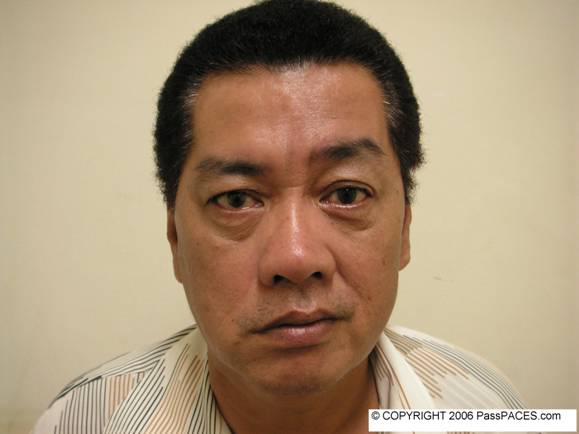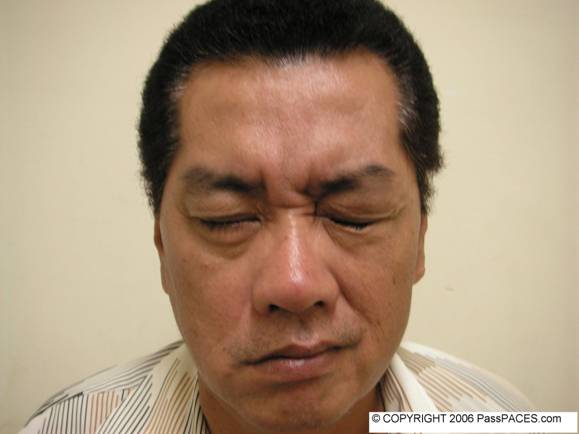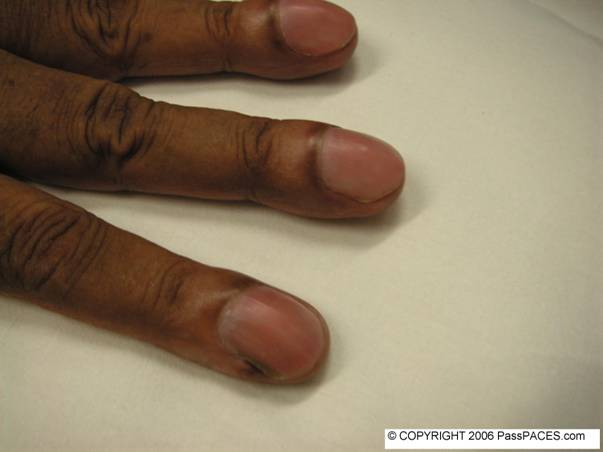
|
|
|||||
|
|
|
|
|
|
|
![]()
YOUR LATEST ISSUE ABOUT MRCP PACES IS HERE!
Would you like to examine this gentleman cranial nerves?

Discussion:
This is a classical case in MRCP PACES station 3. A lot of candidates always feel very worried when faced with cranial nerves examination. You notice that this gentleman has obvious loss of right naso-labial fold. A lot of candidates always ask me the same question, should I examine from the first cranial nerve till the 12th cranial nerve or examine the nerves according to scenario?
I think that it is important for you to divide cranial nerves to 4 main sub-groups, these groups are,
1) Eye group- you will be testing cranial nerves II, III, IV and VI. You will be assessing these cranial nerves by checking eye reflexes, fundoscopy, visual acuity, visual field and eye movement.
2) Facial expression, sensation and movement- you will be testing cranial nerves V and VII. You must check for upper and lower portion of facial expression, corneal reflex ,masseter and pterygoid movement.
3) Articulation and gag reflex- You will be testing cranial nerves IX,X and XII. Check these nerves by assessing palatal movement, gag reflex and tongue movement.
4) Other groups- assess VIII nerve by checking hearing, XI nerves by asking patient to lift the shoulders and the first nerve by assessing smell.
In this case, since you notice this patient has problem mainly due to facial expression and movement, I would examine his V and VII nerves first. You know that he has 7th nerve palsy, the next question you want to ask is whether it is a lower or upper motor 7th nerve palsy. You can differentiate this by observing 2 major upper portion facial muscles namely orbicularis oculi and frontalis muscles. Ask patient to screw his eyes and look upward,
If you do this, you notice the following,

You notice that he is unable to close his right eye tightly as compare to the left eye. So the diagnosis is obvious now, you are dealing with right lower motor 7th nerve palsy.You can then complete other cranial nerves examination. After your examination, you want to find the possible aetiology for his 7th nerve palsy by doing the following steps,
![]() look at external auditory canal for herpes zoster,
look at external auditory canal for herpes zoster,
![]() palpate for parotid swelling,
palpate for parotid swelling,
![]() check for hyperacusis,
check for hyperacusis,
![]() examine the taste involvement ( anterior 2/3)
examine the taste involvement ( anterior 2/3)
![]() test urine for glycouria.
test urine for glycouria.
Common questions examiners would ask you,
1) What are three components of facial nerve?
2) Why there is sapring of upper portion of facial muscles in upper motor lesion of facial nerve?
3) How would manage Bell's palsy?
4) What are the common causes of lower motor facial nerve palsy?
Conclusion:
This gentlema has right Bell's palsy.
Extra points:
1) Bell's palsy should be treated with combination of steroid and acyclovir.
2) To learn about the prognosis of Bell's palsy, click here!
| Case ID: 2 | Created: 7 July 2006 |
Examine this patient's respiratory system.

Discussion:
In MRCP PACES, if you find clubbing in respiratory station, you are dealing with only a few possibilities, the most popular question will be bronchiectasis. Other causes of clubbing because of respiratory system are Lung Cancer, suppurative lung disease ( such as empyema, therefore you would find signs suggesting pleural effusion, however, it is unlikely in MRCP because patients tend to be very ill!) and fibrosing alveolitis. A lot of candidates find it difficult to differentiate lung fibrosis from bronchiectasis. I think there are a few important points to take note...
![]() Patients with bronchiectasis tend to be more ill because they are admitted to hospital because of lung infection.
Patients with bronchiectasis tend to be more ill because they are admitted to hospital because of lung infection.
![]() Crepitation in bronchiectasis is described as coarse and the quality changes with coughing.
Crepitation in bronchiectasis is described as coarse and the quality changes with coughing.
![]() Patients with bronchiectasis produce copious sputum, therefore, always look at sputum cup.
Patients with bronchiectasis produce copious sputum, therefore, always look at sputum cup.
![]() Lung fibrosis patients may have other signs to suggest the underlying cause such as Rheumatoid hands, scleroderma signs etc.Besides that, they might have Cushing features due to long term steroid.
Lung fibrosis patients may have other signs to suggest the underlying cause such as Rheumatoid hands, scleroderma signs etc.Besides that, they might have Cushing features due to long term steroid.
After the examination, suggest to examiners that you would like to look at the temperature chart..
Common questions examiners would ask you,
1) What are the causes of brochiectasis? How would you manage this condition?
2) What are other causes of clubbing?
Conclusion:
This gentleman has bronchiectasis due to previous tuberculosis.
Extra points:
1) In bronchiectasis , remember postural drainage, postural drainage, postural drainage....
2) If you find patient with bronchiectasis also has dextrocardia, the diagnosis is Kartagener's syndrome. To learn more ,click here!
To see previous issues, click here! To send a quick comment, click here!